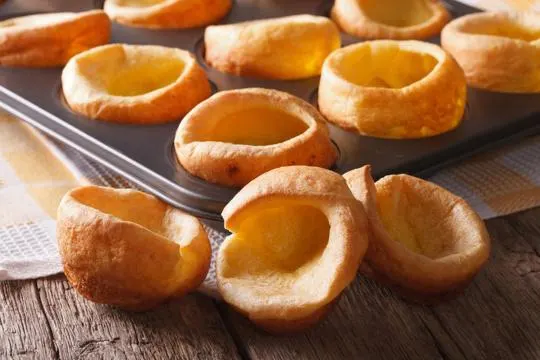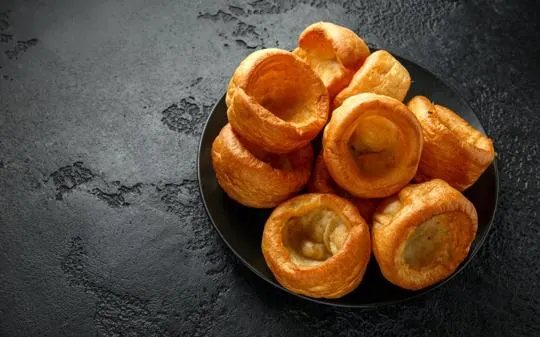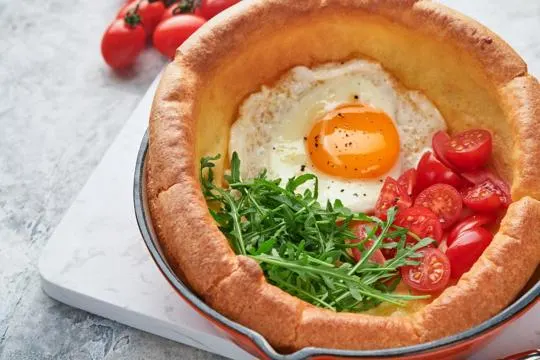Summary of key points
The main difference between Dutch baby and Yorkshire pudding is in their origin and preparation. Dutch baby, also known as a German pancake, is a large, puffy pancake traditionally served for breakfast or brunch. It is baked in the oven and typically has a sweet flavor from added sugar or fruit toppings. Yorkshire pudding, on the other hand, is a savory dish made with a batter of flour, eggs, and milk that is cooked in a hot oven with meat drippings. It is often served as a side dish to roast beef or other meats.
In terms of texture, Dutch baby has a fluffy and custardy interior while Yorkshire pudding has a crispy exterior with a soft and chewy center.
For a sweet breakfast treat, Dutch baby is the way to go. But for a savory side dish, Yorkshire pudding pairs perfectly with rich and hearty meals. Both are delicious options that showcase the versatility of pancake-like dishes.
Ever stared at your brunch menu and wondered what the heck the difference is between a Dutch Baby and a Yorkshire Pudding?
We’ve been there.
Both look easy enough to whip up, yet somehow, each time we tried, they ended up looking like sad, deflated party balloons.
Here’s the scoop: Dutch Babies are like the cool, laid-back cousin of the more formal Yorkshire Pudding. Straight from the oven, Dutch Babies puff up and scream for sweet toppings. Yorkshire Pudding, on the other hand, begs for gravy.
Our kitchen disasters taught us that.
This showdown isn’t just about recipes; it’s a battle of cultures. Ready to dive in?
What is a Dutch Baby?

A Dutch Baby is a one-of-a-kind, scrumptious pancake-like dish from Germany.
The batter is easy to make – just mix eggs, flour, milk, and sugar. Then, bake it in a hot oven.
It will form a large, puffy cake with crispy edges and a soft, custard-like center.
What makes the Dutch Baby so unique is its dramatic rise and presentation.
When baked, the heat causes the batter to puff up, making it look amazing.
The edges become golden and crunchy, while the center remains gooey and eggy.
To guarantee a successful Dutch Baby, you must preheat the baking pan before adding the batter.
This step makes sure the pan is hot enough for that signature rise.
You can enjoy a Dutch Baby sweet or savory.
Top it with powdered sugar, fresh fruit, syrup, cheese, herbs, or even bacon.
This makes it perfect for breakfasts and brunches.
What is a Yorkshire Pudding?

Yorkshire Pudding – a classic British dish. A savory, baked popover made from eggs, flour, and milk.
Best served with roast beef and gravy.
It has an outer crust that’s crispy and a fluffy interior.
Its texture and versatility make it an amazing accompaniment.
The secret to the perfect Yorkshire Pudding? Hot oil or fat in the oven.
This creates steam and causes the batter to rise rapidly.
Making a hollow middle and delicate structure.
Baked in a special pan with individual compartments.
In contrast to Dutch Baby pancakes, Yorkshire Puddings are savory.
Best with rich meat dishes. Both dishes are unique in flavor profiles.
Where did Yorkshire Pudding come from? Northern England in the 18th century.
Initially, a way to stretch limited ingredients. But now, a staple of British cuisine.
It’s popularity has spread around the world.
Differences Between Dutch Baby and Yorkshire Pudding

Dutch Baby and Yorkshire Pudding – so similar, yet so different.
Both dishes have their own charms, and food lovers around the world enjoy them for their delightful tastes and textures.
Origin and History
Dutch Baby and Yorkshire Pudding have unique backgrounds.
Dutch Baby is a German pancake brought to America by German immigrants.
It was inspired by the Dutch appelflap pastry and became popular at Manca’s Café in Seattle, Washington.
Its name “Dutch” is believed to be a mispronunciation of “Deutsch”. Yorkshire Pudding dates back to the 1700s.
It was cooked under roasting meat to catch drippings. It eventually evolved into a separate dish.
Though both recipes use similar ingredients, the cooking methods and presentation differ.
Dutch Baby is typically baked in a cast-iron skillet then placed in the oven, resulting in a thin, delicate texture.
Yorkshire Pudding is poured into hot oil or fat, making golden-brown puddings with crispy edges.
Dutch Baby and Yorkshire Pudding have stood the test of time.
People around the world enjoy these culinary delights.
Ingredients Used
The world of delicious oven-baked treats has two contenders: Dutch Baby and Yorkshire Pudding.
Although they look similar, they’re unique. Dutch Baby requires flour, milk, eggs, sugar, and vanilla extract.
It’s combined to make a thin batter, poured into a hot buttered skillet or baking dish.
The result is a golden, puffy pancake-like creation often topped with powdered sugar, fruit, or syrup.
Yorkshire Pudding requires just four ingredients: flour, milk, eggs, and salt.
Whisk them together until smooth. It’s usually cooked in beef drippings and rises to a crisp, airy texture.
It goes well with roast beef.
Each recipe has common ingredients, but Dutch Baby has sugar and vanilla extract which gives it a sweet flavor.
Yorkshire Pudding has a savory, complementary flavor.
When you’re in the mood for an oven-baked delight, choose between a sweet Dutch Baby or a savory Yorkshire Pudding.
Both recipes will wow your taste buds with their unique blend of ingredients.
Texture and Appearance
When comparing Dutch Baby and Yorkshire Pudding, there are clear differences.
Dutch Baby, also known as a German pancake, has a puffy, custard-like texture.
It has a golden brown color and edges that rise above the pan. It looks impressive and appetizing.
Yorkshire Pudding has a crisp exterior and a soft, airy interior like a slightly flattened popover or hollow roll.
Both dishes look inviting, yet their textures make them unique.
Dutch Baby is versatile when it comes to toppings and fillings.
Its neutral flavor profile allows you to add fruits, sugar, butter, cheese, veggies, or even ham.
You can customize your Dutch Baby according to your preference.
On the other hand, Yorkshire Pudding usually accompanies roast meat or poultry dishes.
It adds texture and flavor to the main course.
It is a simple side dish that still has a distinct appearance.
Serving and Culinary Uses
Dutch baby and Yorkshire pudding have many uses.
They can be eaten as breakfast with sweet toppings like berries, powdered sugar, or syrup.
Savoury toppings like bacon, eggs, or veggies work too.
Or, use them as a side dish or dessert with compote or ice cream.
These pancakes are also customisable. Add herbs, spices, or cheese for extra flavour.
Plus, they look great when served fresh from the oven.
The Dutch baby’s tall edges or the crispness of the Yorkshire pudding make an attractive presentation.
These dishes have cultural meaning too.
Dutch babies come from German-speaking communities in Pennsylvania.
Yorkshire pudding is a traditional British dish, often served with roast beef or Sunday lunches.
Treat yourself to these yummy pancakes. Enjoy endless combinations for any mealtime.
Similarities Between Dutch Baby and Yorkshire Pudding

Dutch Baby and Yorkshire Pudding share many similarities.
They’re both oven-baked dishes with a special puffy texture.
The batter for both recipes is simple – it’s made from flour, eggs, milk and salt.
When cooked at high temperatures, they poof up nicely. They can be served as savory or sweet dishes.
To get that signature puffiness and golden color, cook them in a hot, buttery or oily oven-proof skillet or pan.
Plus, they cook quickly – only 20-30 minutes. However, they do have some differences.
Dutch Baby usually has a touch of vanilla extract in the batter for a hint of sweetness.
Whereas, Yorkshire Pudding has a more savory flavor and is usually served with roast beef and gravy.
How to Make Dutch Baby and Yorkshire Pudding?
Dutch Baby and Yorkshire Pudding are both scrumptious dishes to add some flair to your breakfast or brunch.
Although they may look alike, they have unique qualities that set them apart.
Here’s how to make them.
- Heat the oven: First, preheat your oven to 425°F (220°C). This will ensure your Dutch Baby or Yorkshire Pudding turns out great.
- Mix the batter: For a Dutch Baby, you’ll need flour, milk, eggs, sugar, vanilla extract and salt. Whisk until smooth. For a Yorkshire Pudding, mix flour, milk, eggs and salt until well combined.
- Bake it: Grease a baking dish or skillet with butter. Then pour in the batter. Dutch Baby will form a large pancake-like structure. Yorkshire Pudding must be filled into each section of a muffin tin or a special Yorkshire pudding tin.
Dutch Baby is usually sweet and served with powdered sugar, fresh fruit or maple syrup.
Yorkshire Pudding is savory and often served with roast beef or roasted meats.
Your choice is up to you – sweet or savory. Either way, you’ll have a delicious treat.
Conclusion
All in all, Dutch babies and Yorkshire puddings are beautiful dishes originally from Europe that, while similar, have few unique differences that set them apart.
Those who love both understand the importance of heightening flavor with a variety of ingredients like spices, syrups, and creams.
If you’re still confused which one may be right for your table, consider what flavors you’ll be using in your dish to make it complete.
Additionally, a good rule of thumb is the thickness and texture of the batter as Yorkshire pudding is usually greater than that of Dutch babies.
Finally, think about the presentation.
Both dishes can make for gorgeous tablescapes; Yorkshire puffing presents in impressive tall ridges while Dutch babies have delicately puffed edges.
With this knowledge in mind, there is no doubt you will create a spectacular dish to tantalize your guest’s taste buds.

Leave a comment